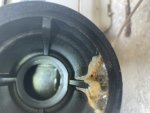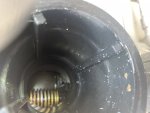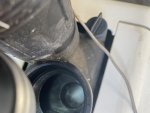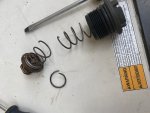Got my new Intellifo VSF installed today, but flow doesn’t seem right
- Thread starter etuser
- Start date
You are using an out of date browser. It may not display this or other websites correctly.
You should upgrade or use an alternative browser.
You should upgrade or use an alternative browser.
Here is a case where some plastic from the de grids broke loose and got into the internal bypass.
You can see the spring part of bypass when you look in the water inlet. You can see the disc part when you remove the thermal bypass and look up where it lines up with the spring part.
If your internal bypass is clogged, that would explain the restriction.
Mastertemp 400 Shutdown Issue & E05 error
Hi all- So last week we had an issue with our heater that I thought we resolved but it happened again today when I went out to turn on the heater. Below is what happened, how we thought we resolved it and what happened since. Any advice is appreciated! Regards, Peter Last Week Issue - last...
Thanks James. Will tackle tomorrow. Is it plausible that something could be lodged in there but the heater still function normally?
Yes, the heater can function normally because the water flow can go through the bypass or through the heat exchanger.
The exit of the heat exchanger is blocked by the thermal regulator until the water in the heat exchanger gets to 120 degrees, which causes the thermal regulator to open.
So, you should actually see a pressure decrease and a gpm increase when the heater starts because the water will go through the heat exchanger and not try to go through the bypass.
When the heater is off, all water goes through the bypass.
When the heater starts, the water now has two paths. One through the bypass and the other through the heat exchanger.
Check the gpm with the heater off and then turn the heater on and recheck the gpm. If the gpm significantly increases at the same rpm, that points to a clogged internal bypass.
The exit of the heat exchanger is blocked by the thermal regulator until the water in the heat exchanger gets to 120 degrees, which causes the thermal regulator to open.
So, you should actually see a pressure decrease and a gpm increase when the heater starts because the water will go through the heat exchanger and not try to go through the bypass.
When the heater is off, all water goes through the bypass.
When the heater starts, the water now has two paths. One through the bypass and the other through the heat exchanger.
Check the gpm with the heater off and then turn the heater on and recheck the gpm. If the gpm significantly increases at the same rpm, that points to a clogged internal bypass.
Last edited:
Here what I see in the inlet and outlet.
Also, here is a video or a rattling sounds I hear occasionally.
Also, here is a video or a rattling sounds I hear occasionally.
Attachments
That's the thermal regulator. It might have been blocking the internal bypass from opening.
Leave the thermal regulator out. Put the threaded plug back in and see what the flow and pressure readings are.
You need a new thermal regulator.
Most likely, the chlorine from the tab feeder caused the damage.
Leave the thermal regulator out. Put the threaded plug back in and see what the flow and pressure readings are.
You need a new thermal regulator.
Most likely, the chlorine from the tab feeder caused the damage.
No difference with and without the regulator. Also, made sure the pipe out of the heater had no debris in it.
Ok, I'm not sure what else you can check.
You seem to have excessive restriction, but nothing obvious is being found.
You can remove the manifold and verify the internal bypass if you want. That would give you the opportunity to look at the ends of the heat exchanger. Based on the condition of the thermal regulator, it's highly likely that the heat exchanger is compromised. The heat exchanger is likely severely corroded or maybe scaled. You would need to replace the manifold O-rings if you remove the manifold.
You should be able to reach into the inlet with something to depress the spring part and watch the disc part while looking in the hole where the thermal regulator goes. See picture of internal bypass.
Other than the 7 suggestions I made earlier. I don't know what else you can do.
Maybe install a 5 psi check valve external bypass for the heater in addition to the 7 suggestions.
You seem to have excessive restriction, but nothing obvious is being found.
You can remove the manifold and verify the internal bypass if you want. That would give you the opportunity to look at the ends of the heat exchanger. Based on the condition of the thermal regulator, it's highly likely that the heat exchanger is compromised. The heat exchanger is likely severely corroded or maybe scaled. You would need to replace the manifold O-rings if you remove the manifold.
You should be able to reach into the inlet with something to depress the spring part and watch the disc part while looking in the hole where the thermal regulator goes. See picture of internal bypass.
Other than the 7 suggestions I made earlier. I don't know what else you can do.
Maybe install a 5 psi check valve external bypass for the heater in addition to the 7 suggestions.
The thermal regulator blocks flow through the heat exchanger until the water in the heat exchanger gets to 120 degrees.Also, what is the purpose or function of the thermal regulator?
Cold water flowing through the heat exchanger creates condensation on the outside of the heat exchanger which can cause corrosion and it can drip water in the combustion chamber, which is not good.
Ok, thanks for all the help! Really appreciate it. One last question - is there a specific spring I need to get, or is that a generic item? The part diagram doesn’t list a part number.
In case it matters, the heater was mfg in 2012. I am very hesitant to remove the manifold since the heater currently functions. I fear if I remove the manifold and do need a need heat exchanger, I will accelerate the need to replace the heater.
Thanks again!
In case it matters, the heater was mfg in 2012. I am very hesitant to remove the manifold since the heater currently functions. I fear if I remove the manifold and do need a need heat exchanger, I will accelerate the need to replace the heater.
Thanks again!
Maybe check the three way valve on the return to see if there's anything clogging it.
You can see the spring part of the bypass in the inlet. Try pushing down on the top part to see if you can see the disc part while looking in the hole where the thermal regulator goes.
You can see the spring part of the bypass in the inlet. Try pushing down on the top part to see if you can see the disc part while looking in the hole where the thermal regulator goes.
Last edited:
You can unscrew the tab feeder and look in the hole to see if anything is caught on the venturi tube.
There's a set screw at the base of the feeder that you need to remove before unscrewing the feeder. Look in the hole at the base for the screw. If the internal bypass plunger broke loose, it would likely get caught on the venturi tube in the feeder T base.
There's a set screw at the base of the feeder that you need to remove before unscrewing the feeder. Look in the hole at the base for the screw. If the internal bypass plunger broke loose, it would likely get caught on the venturi tube in the feeder T base.
Thanks James. Checked those as well and all looks clear. I am thinking this is just inaccurate reporting by the pump.
I just played around with the heater a bit and have a few more data points. The exhaust temperature at 1700 rpms is around 312. The exhaust temp at 1900 rpms is around 308.
I ran it for 10 mins at 1900rpms and then 10 more mins at 1700 rpms and got no low flow error. Is that long enough for it to throw a low flow error? Does the heater throw an error any time it has less than 40gpm of flow?
Thanks!
I just played around with the heater a bit and have a few more data points. The exhaust temperature at 1700 rpms is around 312. The exhaust temp at 1900 rpms is around 308.
I ran it for 10 mins at 1900rpms and then 10 more mins at 1700 rpms and got no low flow error. Is that long enough for it to throw a low flow error? Does the heater throw an error any time it has less than 40gpm of flow?
Thanks!
The heater has a pressure switch and not a flow switch.
The flow could be zero and the heater would still fire as long as there is pressure, but the heater would overheat and shut down.
1,900 seems to be a little bit more efficient than 1,700. Try going a little bit higher on the flow to see if the exhaust temperature goes down some more.
The flow could be zero and the heater would still fire as long as there is pressure, but the heater would overheat and shut down.
1,900 seems to be a little bit more efficient than 1,700. Try going a little bit higher on the flow to see if the exhaust temperature goes down some more.
Thread Status
Hello , This thread has been inactive for over 60 days. New postings here are unlikely to be seen or responded to by other members. For better visibility, consider Starting A New Thread.





